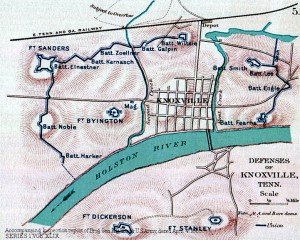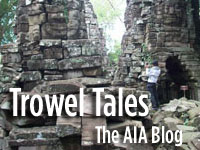Sororities vs. Civil War
by Mark Rose
September 18, 2009
Maybe you saw one or two of the press accounts about the excavation of a Civil War battlefield site in advance of the construction of a “Sorority Village†at the University of Tennessee in Knoxville. If not, have a look at this Knoxnews.com article or this one at WBIR.com . Both reports draw on the university’s August 31 press release. There’s also something in the campus newspaper the Daily Beacon. This is simply my reaction to these sources, the information readily available to the public.
 First, some background. The site is a hilltop Confederate artillery position from the 1863 siege of Knoxville. In late November, the Confederate General Longstreet attacked the city’s Union defenses, selecting Fort Sanders as the point of assault. He abandoned his original plan to shell the fort with cannon fire—the hilltop site had a clear view of Fort Sanders—and instead ordered an infantry charge at dawn on November 29. The attack was a complete disaster. The site is also the place where the Sorority Village, a gated community with 13 residential houses for the sorority chapters, is being built at a cost to the university of $1.25 million for infrastructure and another $45 million or more in funding from the sororities.
First, some background. The site is a hilltop Confederate artillery position from the 1863 siege of Knoxville. In late November, the Confederate General Longstreet attacked the city’s Union defenses, selecting Fort Sanders as the point of assault. He abandoned his original plan to shell the fort with cannon fire—the hilltop site had a clear view of Fort Sanders—and instead ordered an infantry charge at dawn on November 29. The attack was a complete disaster. The site is also the place where the Sorority Village, a gated community with 13 residential houses for the sorority chapters, is being built at a cost to the university of $1.25 million for infrastructure and another $45 million or more in funding from the sororities.
How do a Civil War battlefield site and a Sorority Village get along? Not so well. You might ask how the village was planned for this location to begin with—there seems to have been no mystery that the artillery position was there, it was marked on a map made by a Union officer. Now I realize that not every single archaeological site can be preserved and that at times current needs outweigh preservation and excavation makes sense. How important is this site? Jeff Maples, a university vice chancellor, is quoted as saying “The university appreciates the historical value of this site and we are proud to commemorate the battle and those who took part in this significant event in our nation’s history.†Jeff Chapman, director of the university’s Frank H. McClung Museum is quoted as saying “It’s part of our heritage. Just being here, it’s like going to Gettysburg on a smaller scale.â€
The project has been in the works for more than three years, and, says Maples, “We knew this was a possibility and planned for it before construction.†So, why did the archaeological survey only begin in April? Ideally, with infrastructure work slated to begin in early September, the survey ought to have been done as early as possible to identify where construction plans should be modified to avoid the site and where excavation was necessary. The survey work itself seems to have been straightforward, the University of Tennessee archaeologists digging at intervals trenches perpendicular to the assumed line of the Confederate earthworks. But it could have been done at any time, two or three years ago.
The archaeologists found two cannon emplacements, with the ruts left by the cannon wheels, 42 friction primers used to fire the cannons, belt buckles, and several small hearths cut into the trench wall so that the soldiers could stay warm and out of the line of fire. (A display about the recent excavations will be added to the McClung Museum‘s permanent exhibition on the battle.) But it is unclear how much of the entire stretch of the artillery works, stated as being some 275 feet, was excavated during the four months of fieldwork. Elizabeth Kellar DeCorse of the university’s Archaeological Research Laboratory is quoted as saying the trench held eight or nine cannons, so maybe much of it was not excavated.
As a result of the finds, the Sorority Village plans have been “slightly modified to commemorate this key location in the Siege of Knoxville,†according to the press release. The university is said to be preserving 60 feet of the Confederate artillery trench, but what “preserving†means is unclear. The view toward the location of Fort Sanders is likewise to be “preserved.†The Daily Beacon mentions landscaping and promises “Artist renderings of the proposed finished product should be released in the near future.†The fate of the other 215 feet of the site is not stated explicitly. Steve Dean, president of the Civil War Alliance, is quoted as saying it’s “unfortunate†that some of the cannon emplacements will be “under the [Alpha Omicron Pi] house.†In the press release, Maples states that “We appreciate the collaborative relationship with sorority leaders and our shared commitment to a high-quality development that will enhance what is scenic and historic land for the university.â€
In 1988, the Knoxville Civil War Roundtable published an article commemorating the 125th anniversary of the Battle of Fort Sanders titled “On They Came with a Yell.†It quotes extensively from the letters of Corporal John Watkins of the 19th Ohio Battery. Here is part of his description of the battle:
But all of this did not last more than half an hour for those that were alive in the ditches began to call for quarters and the order was given to cease firing…. There was arrangements made right off to cease hostilities till 7 o’clock in the evening. As soon as the firing stopped I went up and got on the parapet to look at them. And such a sight I never saw before nor do I care about seeing again. The ditch in places was almost full of them piled one on top of the other…. They were brave men. Most of them Georgians.
The article concludes with this observation, “Sadly, were John Watkins to visit the site of Fort Sanders today, he would find the scavenging boys and urban growth had finished their work. Today only a monument erected by the United Daughters of the Confederacy and a Tennessee historical marker identify the site of the bloody struggle for Fort Sanders and for control of East Tennessee.â€
The university plans to put up a plaque to mark the preserved part of the Confederate artillery site in the Sorority Village.
Comments posted here do not represent the views or policies of the Archaeological Institute of America.






 Heather Pringle is a freelance science journalist who has been writing about archaeology for more than 20 years. She is the author of Master Plan: Himmler's Scholars and the Holocaust and The Mummy Congress: Science, Obsession, and the Everlasting Dead. For more about Heather, see our
Heather Pringle is a freelance science journalist who has been writing about archaeology for more than 20 years. She is the author of Master Plan: Himmler's Scholars and the Holocaust and The Mummy Congress: Science, Obsession, and the Everlasting Dead. For more about Heather, see our 



